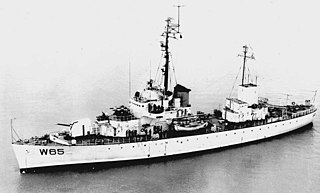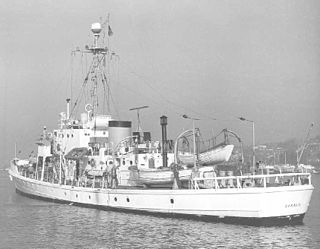
USCGC Jarvis (WHEC-725) was a Hamilton-class cutter of the United States Coast Guard. She was launched on 24 April 1971 and commissioned on 4 August 1971 homeported at Honolulu, Hawaii; served on Ocean Station November and fisheries patrols and search and rescue missions in the Bering Sea. She received a FRAM upgrade in 1990–2. Jarvis was decommissioned on 2 October 2012 and in January 2013 the Coast Guard announced that she would be transferred to the Bangladesh Navy late that year. She was commissioned as BNS Somudra Joy (F-28) on 23 December 2013.

USS Coos Bay (AVP-25) was a United States Navy Barnegat-class small seaplane tender in commission from 1943 to 1946 that saw service during the latter half of World War II. After the war, she was in commission in the United States Coast Guard from 1949 to 1966 as the cutter USCGC Coos Bay (WAVP-376), later WHEC-376.

USS Cook Inlet (AVP-36) was a United States Navy Barnegat-class small seaplane tender in commission from 1944 to 1946. She tended seaplanes during World War II in the Pacific and earned one battle star for her service. After the war, she was transferred to the United States Coast Guard, and was in commission as the Coast Guard cutter USCGC Cook Inlet (WAVP-384), later WHEC-384, from 1949 to 1971. She saw service in the Vietnam War during her Coast Guard career, receiving two campaign stars for her operations during the conflict. Transferred to South Vietnam in 1971, she operated as the Republic of Vietnam Navy frigate RVNS Trần Quốc Toản (HQ-06) until South Vietnam's collapse in April 1975 at the end of the Vietnam War. She fled to the Philippines and in 1976 was transferred to the Philippine Navy, which never commissioned her, instead using her as a source of spare parts for her sister ships, the Andrés Bonifacio-class frigates, before discarding her in 1982.

USS Unimak (AVP-31) was a United States Navy Barnegat-class small seaplane tender in commission from 1943 to 1946 that saw service in World War II. After the war, she was in commission in the United States Coast Guard as the cutter USCGC Unimak (WAVP-379), later WHEC-379, WTR-379, and again WHEC-379, from 1949 to 1975 and from 1977 to 1988.

USCG Owasco (WHEC-39) was an Owasco class high endurance cutter which served with the US Coast Guard from 1945 to 1973. Originally intended for World War II service, she was commissioned only weeks before the end of the war and consequently did not see combat until her deployment in the Vietnam War more than 20 years later.

USCG Winnebago (WHEC-40) was an Owasco-class high endurance cutter which served with the United States Coast Guard from 1945 to 1973. Originally intended for World War II service, she was commissioned only weeks before the end of the war and consequently did not see combat until her deployment in the Vietnam War more than 20 years later.

USCG Chautauqua (WHEC-41) was an Owasco-class high endurance cutter which served with the US Coast Guard from 1945 to 1973. Originally intended for World War II service, she was commissioned only days before the end of hostilities and consequently never saw combat.

USCG Sebago (WHEC-42) was an Owasco class high endurance cutter which served with the US Coast Guard from 1945 to 1972. Originally intended for World War II service, she was not commissioned until a month after the end of hostilities and consequently did not see combat until her deployment in the Vietnam War more than 20 years later.

USCGC Iroquois (WHEC-43) was an Owasco-class high-endurance cutter built for World War II service with the United States Coast Guard. The war ended before the ship was completed and consequently she never saw wartime service.

USCGC Escanaba (WHEC-64) was an Owasco-class high endurance cutter built for World War II service with the United States Coast Guard. The war ended before the ship was completed and consequently she never saw wartime service.

USCGC Winona (WHEC-65) was an Owasco class high endurance cutter built for World War II service with the United States Coast Guard. The war ended before the ship was completed and consequently she did not see wartime service until the Vietnam War.

USCGC Klamath (WHEC-66) was an Owasco-class high endurance cutter built for World War II service with the United States Coast Guard. The war ended before the ship was completed and consequently Klamath did not see wartime service until the Vietnam War.

USCGC Minnetonka (WHEC-67) was an Owasco class high endurance cutter built for World War II service with the United States Coast Guard. The war ended before the ship was completed and consequently Minnetonka did not see wartime service until the Vietnam war.

USCGC Androscoggin (WHEC-68) was an Owasco-class high endurance cutter built for World War II service with the United States Coast Guard. The war ended before the ship was completed and consequently Androscoggin did not see wartime service until the Vietnam war.

USCGC Mendota (WHEC-69) was an Owasco class high endurance cutter built for World War II service with the United States Coast Guard. The ship was commissioned three months before the end of the war and did not see combat action until the Vietnam war.

USCGC Pontchartrain (WHEC-70) was an Owasco class high endurance cutter built for World War II service with the United States Coast Guard. The ship was commissioned just days before the end of the war and thus did not see combat action until the Korean war.

USS Rockaway (AVP-29), later AG-123, was a United States Navy Barnegat-class seaplane tender in commission from 1943 to 1946. She served in both the Atlantic Ocean and the Pacific Ocean during World War II. In 1948, she was loaned to the United States Coast Guard, in which she served as the cutter USCGC Rockaway (WAVP-377), later WAGO-377, WHEC-377, and WOLE-377, from 1949 to 1972.

The Casco class was a large class of United States Coast Guard cutters in commission from the late 1940s through the late 1980s. They saw service as weather reporting ships in the Atlantic and Pacific Oceans until the early 1970s, and some saw combat service during the Vietnam War.
USCGC Clover WAGL/WLB/WMEC-292, a Cactus (A) Class buoy tender was built by Marine Iron and Shipbuilding, Duluth, Minnesota. Her keel was laid 3 December 1941, and she was launched 25 April 1942. She was commissioned on 8 November 1942 in the United States Coast Guard as the United States Coast Guard Cutter Clover. She was built as a WAGL, redesignated a WLB in 1965, and again redesignated a WMEC in 1979.

USCGC Cahoone (WPC/WSC/WMEC-131) was an Active-class patrol boat of the United States Coast Guard. Launched in 1927, she served until 1968.



















